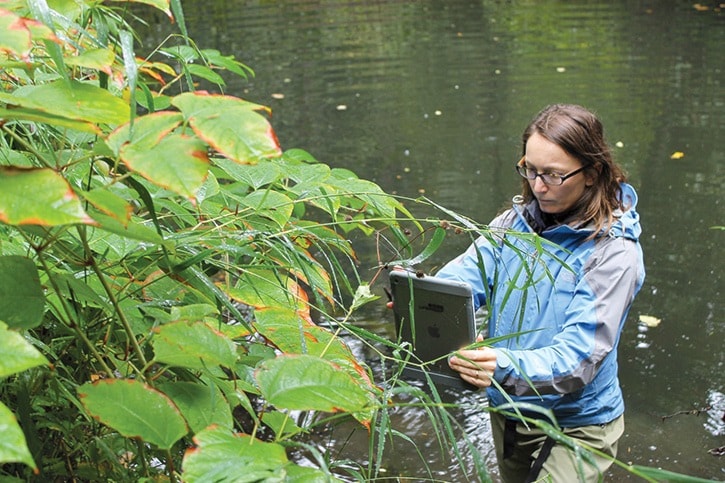Becky Brown, invasive plant specialist, drops down into the Millstone River, just deep enough to get a good picture of Japanese knotweed pushing though wire mesh along the bank.
Removing the noxious, bamboo-like plant has challenges near waterways where the most effective treatment, systemic herbicide, isn’t allowed. A new study underway since May at Bowen Park will see if wire mesh can help girdle its growth.
The trial, part of the Invasive Plant Management Program and a partnership between City of Nanaimo and B.C. government, is at the only two known knotweed sites along the Millstone River. The hope is mesh will contain growth of the plant’s canes, which are larger than the size of the wire openings, and prevent fragments from moving downstream in high-water where they can regrow.
“The mesh idea is never going to eradicate a site but…we’re trying to see if it’s going to restrict and contain growth at the very least,” said Brown, who’s with the B.C. Ministry of Forests, Lands and Natural Resource Operations.
Japanese knotweed is much more than a nuisance; where it occurs it’s having significant impacts, according to Brown. It can grow 1.2 metres through concrete, posing a risk to infrastructure, the ministry of forests reports, and there’s environmental concerns.
Diversity of plants, understory and trees along the river, means an intermingling of roots, greater bank stability and habitat for wildlife, Brown said, adding it’s not good at holding soil together so there’s more erosion, sedimentation in the water and poorer water quality. Once grown to maturity, there’s no access to the water.
Japanese knotweed can grow to a maximum height of three meters but the majority of the plant mass is underground where roots can spread seven metres down and 20 metres out. Brown said the most effective way to treat the plant is systemic herbicides, but there’s no standing permits in place in the province that allow use in and around water.
In B.C. there’s still an “incredible opportunity – the majority of our water systems are not yet choked with knotweed,” said Brown. “We are kind of at a tipping point right now where we need to start doing things differently, so we are trying all kinds of trials.”
Rob Lawrance, city interim parks and open space planner, said there were 20 sites with the knotweed last year, with two at Millstone.
“We wanted to try and control this as quickly as possible to stop it from spreading,” he said, adding the city hopes the mesh is an effective treatment because it’s a difficult and sensitive site to manage and there is concern about the plant spreading any further on the Millstone.
To report invasive plants, please go to www.reportinvasives.ca. Brown asks people not to use the mesh on knotweed until proven effective.
